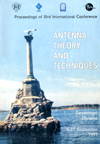Principal problems of the reflector antennas synthesis
DOI:
https://doi.org/10.1109/ICATT.1999.1236101Abstract
An idea to controlling the radiation field at changing medium parameters and a form of boundary surfaces initially has been proposed in optics, though the practical development it has gained in the antenna techniques, in particular, when developing reflector and lens antennas. A great deal of works were devoted to the expedient synthesis of reflector antennas (and generally to two-surface ones) in geometrical approximation. As a rule, forms of wave fronts with the distributions of electromagnetic field vectors prescribed on them had been used as the initial data, that is a certain continuously-unique conformity between points of these forms had been given.References
Keenber, B.E. About two-reflector antenna. Radiotekhnika I Elektronika. 1962, No. 6.
Bakhrakh, L.D.; Tarasov, V.B. Accurate geometrooptical synthesis of two-surface lens and reflector antennas of general type. Antennas. 1997, No. 1 (38).
Bakhrakh, L.D.; Tarasov, V.B. Expedient trans-formation of wave amplitude-polarization characteristics in two-reflector systems of general kind. Electromagnitnye Volny I Elektronnye Systemy. 1996, Vol. 1, No. 1.
Kamke, E. Handbook on Differential Equations in Partial Derivatives of the First Order. M.: Nauka, 1966 [in Russian].
Published
1999-09-14
Issue
Section
Invited papers

